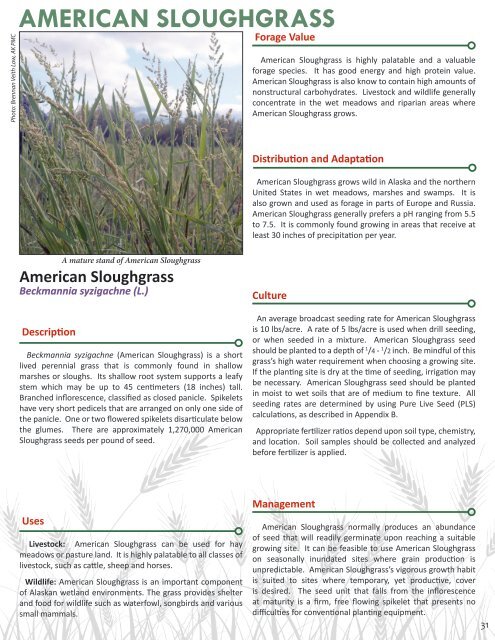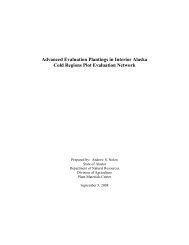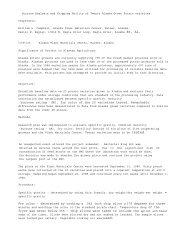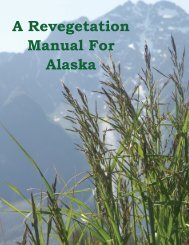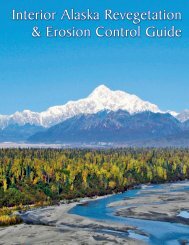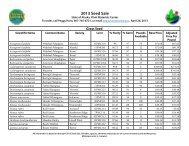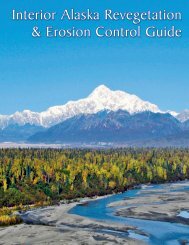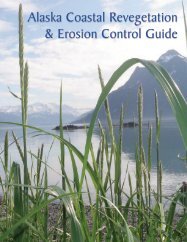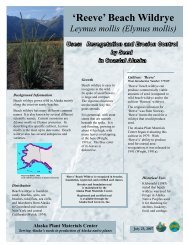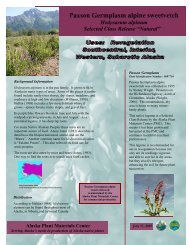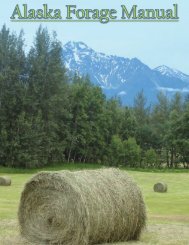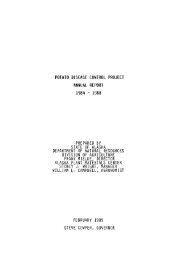Alaska Forage Manual - Alaska Plant Materials Center - State of ...
Alaska Forage Manual - Alaska Plant Materials Center - State of ...
Alaska Forage Manual - Alaska Plant Materials Center - State of ...
You also want an ePaper? Increase the reach of your titles
YUMPU automatically turns print PDFs into web optimized ePapers that Google loves.
Photo: Brennan Veith Low, AK PMC<br />
AMERICAN SLOUGHGRASS<br />
<strong>Forage</strong> Value<br />
American Sloughgrass is highly palatable and a valuable<br />
forage species. It has good energy and high protein value.<br />
American Sloughgrass is also know to contain high amounts <strong>of</strong><br />
nonstructural carbohydrates. Livestock and wildlife generally<br />
concentrate in the wet meadows and riparian areas where<br />
American Sloughgrass grows.<br />
Distribution and Adaptation<br />
American Sloughgrass grows wild in <strong>Alaska</strong> and the northern<br />
United <strong>State</strong>s in wet meadows, marshes and swamps. It is<br />
also grown and used as forage in parts <strong>of</strong> Europe and Russia.<br />
American Sloughgrass generally prefers a pH ranging from 5.5<br />
to 7.5. It is commonly found growing in areas that receive at<br />
least 30 inches <strong>of</strong> precipitation per year.<br />
A mature stand <strong>of</strong> American Sloughgrass<br />
American Sloughgrass<br />
Beckmannia syzigachne (L.)<br />
Description<br />
Beckmannia syzigachne (American Sloughgrass) is a short<br />
lived perennial grass that is commonly found in shallow<br />
marshes or sloughs. Its shallow root system supports a leafy<br />
stem which may be up to 45 centimeters (18 inches) tall.<br />
Branched inflorescence, classified as closed panicle. Spikelets<br />
have very short pedicels that are arranged on only one side <strong>of</strong><br />
the panicle. One or two flowered spikelets disarticulate below<br />
the glumes. There are approximately 1,270,000 American<br />
Sloughgrass seeds per pound <strong>of</strong> seed.<br />
Culture<br />
An average broadcast seeding rate for American Sloughgrass<br />
is 10 lbs/acre. A rate <strong>of</strong> 5 lbs/acre is used when drill seeding,<br />
or when seeded in a mixture. American Sloughgrass seed<br />
should be planted to a depth <strong>of</strong> 1 /4 - 1 /2 inch. Be mindful <strong>of</strong> this<br />
grass’s high water requirement when choosing a growing site.<br />
If the planting site is dry at the time <strong>of</strong> seeding, irrigation may<br />
be necessary. American Sloughgrass seed should be planted<br />
in moist to wet soils that are <strong>of</strong> medium to fine texture. All<br />
seeding rates are determined by using Pure Live Seed (PLS)<br />
calculations, as described in Appendix B.<br />
Appropriate fertilizer ratios depend upon soil type, chemistry,<br />
and location. Soil samples should be collected and analyzed<br />
before fertilizer is applied.<br />
Uses<br />
Livestock: American Sloughgrass can be used for hay<br />
meadows or pasture land. It is highly palatable to all classes <strong>of</strong><br />
livestock, such as cattle, sheep and horses.<br />
Wildlife: American Sloughgrass is an important component<br />
<strong>of</strong> <strong>Alaska</strong>n wetland environments. The grass provides shelter<br />
and food for wildlife such as waterfowl, songbirds and various<br />
small mammals.<br />
Management<br />
American Sloughgrass normally produces an abundance<br />
<strong>of</strong> seed that will readily germinate upon reaching a suitable<br />
growing site. It can be feasible to use American Sloughgrass<br />
on seasonally inundated sites where grain production is<br />
unpredictable. American Sloughgrass’s vigorous growth habit<br />
is suited to sites where temporary, yet productive, cover<br />
is desired. The seed unit that falls from the inflorescence<br />
at maturity is a firm, free flowing spikelet that presents no<br />
difficulties for conventional planting equipment.<br />
31


